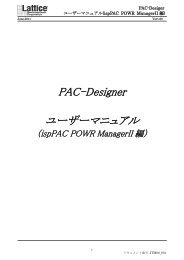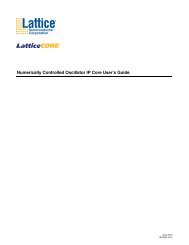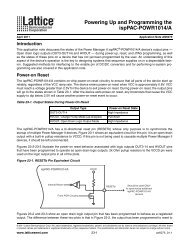Lattice ispMACH 4000 ZC/ZE Product Family Qualification Summary
Lattice ispMACH 4000 ZC/ZE Product Family Qualification Summary
Lattice ispMACH 4000 ZC/ZE Product Family Qualification Summary
Create successful ePaper yourself
Turn your PDF publications into a flip-book with our unique Google optimized e-Paper software.
1.0 INTRODUCTION<br />
The <strong>ispMACH</strong> <strong>4000</strong> <strong>Product</strong> <strong>Family</strong> offers a SuperFAST CPLD solution. The <strong>ispMACH</strong> <strong>4000</strong> <strong>Family</strong> includes 3.3,<br />
2.5, 1.8 volt power supply, and 1.8- volt zero power versions, designated <strong>ispMACH</strong> <strong>4000</strong>V, <strong>ispMACH</strong> <strong>4000</strong>B,<br />
<strong>ispMACH</strong> <strong>4000</strong>C, <strong>ispMACH</strong> <strong>4000</strong><strong>ZC</strong> and <strong>ispMACH</strong> <strong>4000</strong><strong>ZE</strong> devices respectively. The <strong>ispMACH</strong> <strong>4000</strong><strong>ZC</strong>/<strong>ZE</strong><br />
.<strong>Product</strong> <strong>Family</strong> offers densities ranging from 32 to 256 macrocells.<br />
The <strong>ispMACH</strong> <strong>4000</strong><strong>ZC</strong>/<strong>ZE</strong> product families are built on <strong>Lattice</strong> Semiconductor’s 1.8V EE9 process. EE9 is a<br />
shallow trench isolated 0.18um Leff CMOS process with Electrically Erasable cell (E2 cell) modules. This process<br />
uses five, planarized metal interconnect layers and single layer polysilicon. The <strong>ispMACH</strong> <strong>4000</strong><strong>ZE</strong> product family is<br />
built at Seiko Epson. The <strong>ispMACH</strong> <strong>4000</strong><strong>ZC</strong> product family is built at Seiko Epson and United Microelectronics<br />
Corporation (UMC).<br />
The high performance <strong>ispMACH</strong> <strong>4000</strong><strong>ZE</strong> family from <strong>Lattice</strong> offers an ultra low power CPLD solution. The new<br />
family is based on <strong>Lattice</strong>’s industry-leading <strong>ispMACH</strong> <strong>4000</strong> architecture. Retaining the best of the previous<br />
generation, the <strong>ispMACH</strong> <strong>4000</strong><strong>ZE</strong> architecture focuses on significant innovations to combine high performance with<br />
low power in a flexible CPLD family. For example, the family’s new Power Guard feature minimizes dynamic power<br />
consumption by preventing internal logic toggling due to unnecessary I/O pin activity. The <strong>ispMACH</strong> <strong>4000</strong><strong>ZC</strong>/<strong>ZE</strong><br />
combines high speed and low power with the flexibility needed for ease of design. With its<br />
robust Global Routing Pool and Output Routing Pool, this family delivers excellent First-Time-Fit, timing<br />
predictability,<br />
This report details the reliability qualification results of the initial <strong>ispMACH</strong> <strong>4000</strong><strong>ZC</strong>/<strong>ZE</strong> product introduction built at<br />
Seiko Epson and United Microelectronics Company (UMC). To verify product reliability, <strong>Lattice</strong> Semiconductor<br />
maintains an active Early Life and Inherent Life Reliability Monitor program on the <strong>ispMACH</strong> <strong>4000</strong> products. <strong>Lattice</strong><br />
Semiconductor publishes the Reliability Monitor Data quarterly.<br />
Table 1.1 <strong>Lattice</strong> <strong>ispMACH</strong> <strong>4000</strong><strong>ZE</strong> <strong>Product</strong> <strong>Family</strong> Attributes<br />
<strong>ispMACH</strong><br />
4032<strong>ZE</strong><br />
<strong>ispMACH</strong><br />
4064<strong>ZE</strong><br />
4<br />
<strong>ispMACH</strong><br />
4128<strong>ZE</strong><br />
<strong>ispMACH</strong><br />
4256<strong>ZE</strong><br />
Macrocells 32 64 128 256<br />
I/O + Dedicated<br />
Inputs<br />
32+4/32+4 32+4/48+4/48+4<br />
64+10/64+10<br />
64+10/96+4/96+4/<br />
96+4<br />
64+10/96+14/<br />
108+4<br />
tPD (ns) 4.4 4.7 5.8 5.8<br />
tS (ns) 2.2 2.5 2.9 2.9<br />
tCO (ns) 3.0 3.2 3.8 3.8<br />
fMAX (MHz) 260 241 200 200<br />
Supply Voltages (V) 1.8V 1.8V 1.8V 1.8V<br />
Fabrication Site Seiko Epson Seiko Epson Seiko Epson Seiko Epson<br />
Process Technology EE9 180nm<br />
(E2 cell)<br />
Die Size<br />
(W x L x T)<br />
1770 x 1910 x 330-<br />
381 (um)<br />
EE9 180nm<br />
(E2 cell)<br />
2490 x 1960 x 330-381<br />
(um)<br />
EE9 180nm<br />
(E2 cell)<br />
3280 x 3150 x 330-<br />
381 (um)<br />
EE9 180nm<br />
(E2 cell)<br />
3530 x 4180 x 330-<br />
381 (um)<br />
Die Metallization Al – 0.5% Cu Al – 0.5% Cu Al – 0.5% Cu Al – 0.5% Cu<br />
Die Interconnect<br />
Dielectric<br />
Pins/Packages<br />
(Lead-Free only)<br />
INDEX Return<br />
Plasma-enhanced<br />
TEOS<br />
48 TQFP<br />
64 csBGA<br />
Plasma-enhanced<br />
TEOS<br />
48 TQFP<br />
64 csBGA<br />
64 ucBGA<br />
100 TQFP<br />
144 csBGA<br />
Plasma-enhanced<br />
TEOS<br />
100 TQFP<br />
132ucBGA<br />
144 TQFP<br />
144 csBGA<br />
Plasma-enhanced<br />
TEOS<br />
100 TQFP<br />
144 TQFP<br />
144 csBGA










